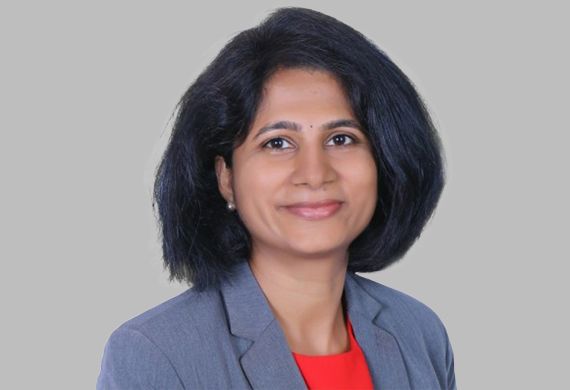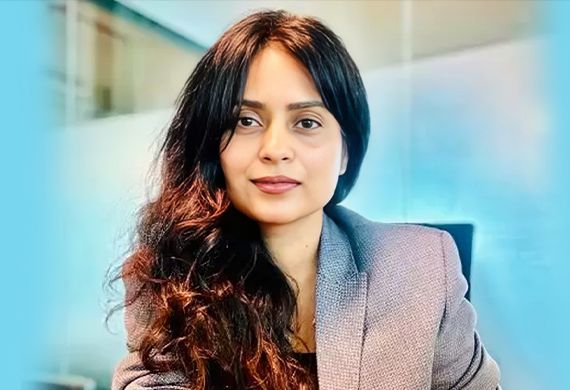
Semiconductor IT at the Edge: Cloud, AI, Cybersecurity & the Future of Innovation
By: Radhika Chennakeshavula, Chief Information Officer (CIO), Silicon Labs
Radhika Chennakeshavula is a Customer & People-focused leader, armed with over 25 years of experience in value creation. She is a seasoned professional with experience working across a global ecosystem. Her credentials include a Six Sigma Black Belt and Information Technology Infrastructure Library (ITIL) certification, complemented by more than 16 years of experience in managing large teams.
In a conversation with Women Entrepreneurs Review Magazine, Radhika shares deep insights from her experience leading Silicon Labs as the CIO. She talks about how to strategically balance innovation with legacy systems in the semiconductor industry, emphasizing ROI (return on investment)-driven decisions, AI adoption, and global collaboration. The conversation highlights the importance of cybersecurity, cloud scalability, and regionally integrated leadership to drive meaningful digital transformation.
Read the article to know more.
With technology rapidly evolving, how do you balance the need for innovation with the practical constraints of legacy systems, especially in an industry like semiconductor manufacturing?
First and foremost, in high-tech or semiconductor industries, innovation isn't optional—it's the lifeblood of these companies. You constantly need to stay ahead of solutions and end products so that innovation drives your offerings to market.
That said, in IT specifically, there are countless tools and innovations emerging all the time. I believe in being cautious with quick adoption. To use an analogy—I don’t follow fashion trends. Some leaders I’ve worked with get excited about the latest tools because they're popular. But I don’t believe in adopting a tool simply because other CIOs are using it.
Instead, I focus on ROI and relevance of the solution. Since Silicon Labs is an innovator in low-power wireless and Internet of Things (IoT) solutions—not an IT product company—ITs role is to enable business processes and provide the infrastructure to deliver our IoT solutions, both hardware and software.
So, I look for tools that directly support our product delivery and business goals. I avoid bleeding-edge technology unless it adds value. I choose innovations based on their ability to increase revenue, improve sales, enhance market position, produce more manufacturing yield, or drive other tangible benefits.
That's the balance—keeping an eye on innovation while making deliberate, ROI-driven decisions. And I believe that’s the right approach for IT leaders in general.
How is the convergence of AI, cloud computing, and data analytics reshaping the semiconductor manufacturing landscape? What key strategies are you employing to ensure your company is a leader in this transformation?
AI is undeniably here to stay. In my experience—including previous companies—Silicon Labs has been a quick adopter of Generative AI tools. While many industry leaders hesitated or imposed security restrictions around 10 months ago when these tools began emerging, Silicon Labs had already begun evaluating around 16 tools. Many are now in full production.
Some examples include:Ask.ai on the Silicon Labs website, which addresses thousands of customer queries daily; Kapa.ai on docs.siliconlabs.com, helping users navigate our extensive product documentation; GitHub Copilot and Zoom Copilot for software development support; LLaMA and other models in production.
We have governance in place. Anyone exploring a new tool submits it for review to our internal GenAI Council, which evaluates it from a security and compliance perspective before approval. For instance, even DeepSeek, which appeared just two days ago, already has an active review request. We adopt AI rapidly—because we must.
Moving to the cloud, in the semiconductor space, it’s not optional. Our product lifecycle—from R&D through validation and manufacturing—involves heavy simulation workloads that require substantial compute and storage. On-prem data centers can’t scale fast enough. That’s why we use the cloud for burst workloads, scaling up during intense periods, then scaling back down.
Lastly, regarding analytics—yes, we use it, but not enough. This is an area with significant untapped potential at Silicon Labs. We remain somewhat traditional in our reporting. A key focus now is enhancing how we use analytics to make sense of the data we gather and ultimately improve decision-making.
What unique challenges do you face in aligning IT strategies across diverse geographies? How do you ensure that regional insights are integrated into your overarching technological vision?
The global environment, especially in the semiconductor industry, is inherently complex. I've worked with multinational companies for over 27 years, and this complexity stems from operations being spread across geographies. For example, semiconductor headquarters are often in Silicon Valley or Austin—mostly in North America. Manufacturing, on the other hand, has largely shifted to Asia—Taiwan, Malaysia, and Singapore. R&D and IT centers are primarily based in India. This global distribution means navigating multiple time zones, understanding local dynamics, and dealing with varying political and regulatory landscapes.
The way one navigates this environment varies by company. Silicon Labs took a bold step by moving the CIO role to Hyderabad, India. That adds another layer of complexity, particularly with government relations, tax regulations, and compliance.
To align regional and global interests, I wear multiple hats. As CIO, my role is to ensure IT strategies align with broader company goals. As a leader in India, I also focus on contributing to the local ecosystem. I engage actively with institutions like IIIT, IESA, and other forums to maintain ongoing dialogue and ensure we’re contributing meaningfully to local communities.
What are some misconceptions that businesses have regarding cybersecurity in the semiconductor sector? How can CIOs address these gaps effectively while still promoting innovation?
One of the biggest myths that has been broken is the idea that we are safe — that we won’t be attacked. That’s simply not true. Everyone is vulnerable to cyberattacks; it’s just a matter of time.
In my previous role at Western Digital, I had to navigate through an entire ransomware attack. It was extremely difficult. The identity of the company was in question. We had to rebuild several systems, work with the U.S. government, deal with agencies we’d rather avoid, manage media narratives, calm panicked employees, and reassure anxious customers.
After that experience, I made it a priority to ensure that cybersecurity would always be at the top of my agenda, no matter where I work. Today at Silicon Labs, I closely partner with our Chief Security Officer. In cybersecurity terms, he handles the “left side” — identifying threats, vulnerabilities, and problems. I manage the “right side” — remediation, defining controls and policies, and implementing governance.
My team and I are constantly working to strengthen our cybersecurity posture.
The threat landscape is always evolving, especially with the rise of AI tools and sophisticated algorithms.
So, the bottom line is: don’t assume you’re safe. A cyberattack will happen. The only way forward is to stay vigilant and prioritize cybersecurity at every level.
How do you foster collaboration between IT teams in emerging tech hubs like India and your international counterparts? What frameworks are most effective in bridging cultural and operational differences to build high-performing global IT teams?
When global centers are set up in India, our initial priority is to scale the team hiring across multiple functions. It's crucial to define an operating model that is locally governed and managed. For instance, appoint an India Head of IT or an overall India Head with decision-making authority. This reduces dependency on headquarters for hiring and interviewing, allowing faster scaling.
At the same time, fostering cultural exchange is essential. Two approaches that worked for me:
Two-way travel: Plan for key people from both headquarters and India to visit each other—be it the US, Singapore, Taiwan, or wherever HQ is located. This helps build mutual understanding and cultural alignment.
Expat assignments: In companies I’ve worked with—mainly North America-based—we’ve brought in long-tenured employees from HQ to India. Their presence helps transfer the company’s culture.
In the long term, sustaining these roles requires functional and metrics-based global reporting. Without it, India centers risk being viewed as external vendors rather than integrated parts of the organization. Leaders at HQ should have ownership of team members in India, and vice versa. This shared accountability drives true collaboration.
Lastly, the Indian leader and HR business partner must work closely to continually develop the required skills and capabilities. Their partnership plays a pivotal role in the success of the India center.
How do you foresee emerging technologies like quantum computing, 5G, or edge computing impacting the semiconductor industry? What future-focused strategies are you employing to not just adapt to these shifts but anticipate and capitalize on them early?
Our business is deeply focused on the edge—our IoT chips are the core products in many consumer devices like Garmin watches and IKEA sensors, with applications spanning the industrial and commercial, smart city, smart home sectors, and more.
When it comes to staying current with modern technologies, I see it as a cycle of continuous innovation and evolution. You innovate, products adopt the innovation, consumers embrace the products, and their feedback leads to further refinement. It creates a virtuous cycle of innovation and solution delivery—something that's worked across generations.
This approach extends to our regional strategy. In India, for example, we are actively watching developments in smart cities and smart metering. To capitalize on these opportunities, we collaborate with local institutions. Our recent Wireless Smart Ubiquitous Network (Wi-SUN) challenge with the International Institute of Information Technology (IIIT) generated over 270 ideas for applications in areas like agriculture and home automation, and we are now integrating our chips into many of these concepts. This cycle of innovation and collaboration is how we stay aligned with modern technologies and move forward.
Last Word
My message to women is this: We often don’t see enough women in technology or senior leadership positions. That’s partly because we don’t see enough leaders at the top stepping forward and sharing their stories.
I urge women leaders to look up and recognize that there are many opportunities in the tech space. Stay committed, be patient, keep dreaming—and you will shine. I wish you all the very best, and I look forward to seeing more women in senior technology leadership roles.
Most Viewed
- 1 Women's Health Startup HerMD Closing Doors Amid Industry Challenges
- 2 5 Famous Women in Indian Armed Forces
- 3 Saudi Women No longer Require Male Permission for Clothing Choices, says Prince MbS
- 4 Kolkata Medtech Startup Innovodigm Raises Rs 5.5 Crore Seed Funding Led by IAN Group
- 5 Yamunanagar's Kashish Kalra Honoured after Securing 111th Rank in UPSC Civil Services Exam
- 6 Madurai Appoints Its First Woman Corporation Head
- 7 IAS Vijayalakshmi Bidari Appointed as the new Nagpur Divisional Commissioner
- 8 American Entrepreneur Lucy Guo Overtakes T Swift to become Youngest Female Billionaire
- 9 ICC Women's World Cup 2025 Trophy Showcased at Indore's Holkar Stadium
- 10 Aparna Saxena's Beauty Venture AntiNorm Launches in India
- 11 Vidya Nataraj Co-Founded BlueStone Jewellery & Lifestyle files IPO
- 12 5 Women Freedom Fighters of India
- 13 Dr. G Krishnapriya appointed as CEO for Trichy
- 14 M3M & Sirona Partner to Introduce Menstrual Hygiene Vending Machines in 15 Locations
- 15 Punjab Govt launches SHE Cohort 3.0 Supporting Tech-led Women Startups
- 16 Indian origin Lawyer, Sweena Pannu appointed as the US New Superior Court Judge
- 17 The Aurora Tech Award recognizes 4 Indian Women-led Startups
- 18 Kerala's Republic Day parade featured an all-female tableau
- 19 Manisha Kabbur Becomes Karnataka's First Woman International Karate Coach
- 20 Director K. S. Ravikumar's Daughter Maalica Ravikumar Launches Life Coaching Company 'Evergrowth Academy' for Women
- 21 Leezu's Raises Pre-Seed Funding to Accelerate Growth in Sexual Wellness Industry
- 22 Sattu: Super-easy summer drink for PCOS gut healing
- 23 Swathi Nelabhatla creates Sitha App, India's First Women-Exclusive Gig Platform
- 24 7 Timeless Female Kathak Dancers & their Iconic Legacies
- 25 Meet 7 Iconic Women Architects of Modern India & their Most Impactful Work
- 26 This Woman-led Insuretech Startup is Helping Bridge the Education Financing Gap in India
- 27 Women Leaders Share Lessons Learnt from India Women's WC Win
- 28 5 Enterprising Women Founders Powering Singapore's Tech & Innovation Landscape
- 29 4 Women. 4 Stories. One Vision for Smarter, Stronger Healthcare
- 30 Global Gender Gap Narrows to 68.8%, But Full Equality 123 Years Away: WEF Report 2025
- 31 Changemakers: 7 Women Entrepreneurs Taking the Make in India Movement Forward
- 32 Meet Lucy Guo, The Youngest Self-Made Female Billionaire Disrupting Tech
- 33 How Women are Driving India's Festive Online Shopping Surge






